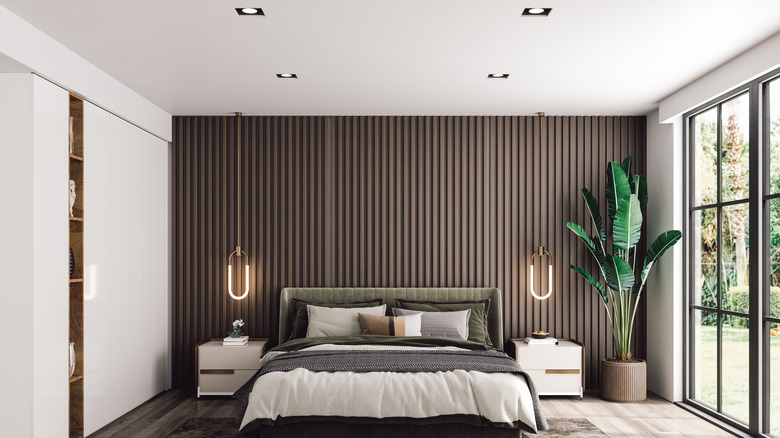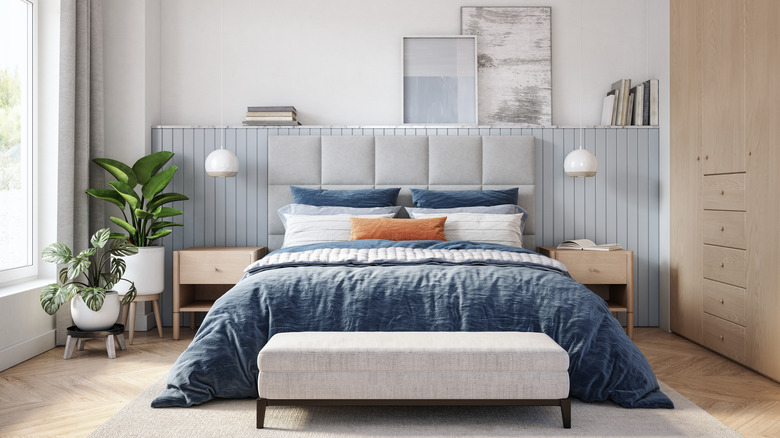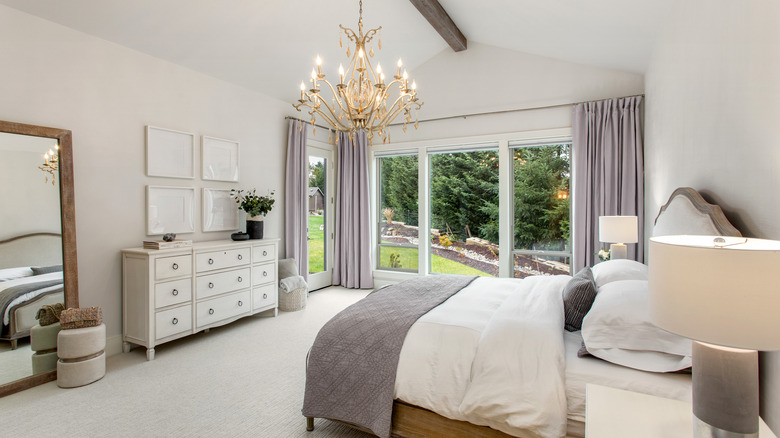Why Design Experts Avoid Recessed Lighting In The Bedroom
Many homeowners opt for recessed lighting, also called can lights, to achieve a clean, modern look. Kitchens come to mind frequently when thinking in this direction. They also make great accent lights to highlight specific areas in a room, like gallery walls featuring special artwork or handsome fireplaces. Some interior designers aren't fans, though, and even call this type of lighting "Swiss cheese" for the ceiling. They especially dislike them when they're installed in bedrooms. Why is that?
"Recessed lights aren't very flattering and can make the ceiling feel busy, especially when you're staring up at it from your bed," interior designer Laura Hodges shared in a Southern Living interview. Even when dimmer switches are installed, too much-recessed lighting can feel like you're basking in the blinding spotlight when all you're trying to do is unwind before bedtime. In lieu, many designers opt for stylish lamps, sconces, or chandeliers rather than recessed lighting as a way to illuminate bedrooms in a less garish way. Lighting with more decorative appeal offers a way to make a space designed for relaxation cozier and more attractive.
Alternatives to recessed lighting in bedrooms
Designers who feel strongly about this topic don't hold back when guiding home decorators contemplating recessed lights. "Ditch the overhead lighting and punctuate your bedroom with beautiful and functional lamps and sconces," interior designer Annie Downing suggests (via Southern Living). Picking lamps that match your décor is important, but so is their functionality. You'll use them for soft lighting when going to bed and waking up, but how about reading? Make sure the lamps you select for bedside tables are bright enough to adequately light the intended space. Three-way lamps are also a good option since they allow you to brighten and dim the light as needed.
Wall sconces and dual pendant lamps are also popular and attractive ways to add light to bedside areas. Some homeowners view sconces as too hotel-like, but with a choice that matches the scheme of the room, they can fit right in. Just remember, if you're not comfortable with DIY electrical projects, you'll have to hire a pro to install sconces or pendant lamps, which adds to the expense. They will also require more extensive home repair work to remove if you tire of them in comparison to replacing tried and true bedside lamps.
Other overhead lighting options for bedrooms
Many homes have ceiling lights in the center of the bedroom that can be replaced with a decorative light fixture or, if you really want to make a statement, a chandelier. Once relegated to ballrooms and mansions, many everyday homes opt for a chandelier in the bedroom since they now come in all shapes and sizes.
To pick the right chandelier size to fit in the center of a bedroom, Shades of Light suggests determining the length and width of your room and then adding those numbers together. Convert that sum to inches, and you have the diameter of a chandelier that's the right size for your room. In other words, if your room is 11 feet wide and 12 feet long, select a chandelier that is 23 inches or so in diameter. Even with a chandelier decorating the room, some homeowners still opt for the convenience of adding bedside lighting.
If you're a hot sleeper and can't live without a ceiling fan in your bedroom, there are now decorative choices for you as well. Fandeliers, which combine the function of a ceiling fan with the look of a stylish light fixture or chandelier, are available in styles to match everything from ultra-modern to chic and elegant rooms. These offer another option to consider as an alternative to recessed lighting.


